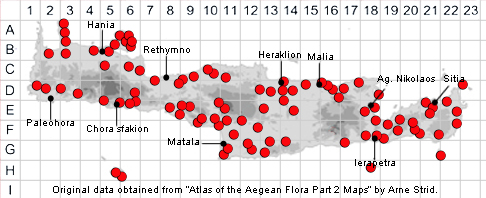RANUNCULUS ASIATICUS
Family and Genus:- See-
Common Names:- Turban buttercup
Homotypic Synonyms:- Cyprianthe asiaticus
Meaning:- Ranunculus (L) Little-frog, diminutive of rana, (reference to water-loving
habit of many species).
Asiaticus (L) From Asia.
General description:- Perennial, with a cluster of narrowly ellipsoid to spindle-
shaped, acute root tubers mixed with longer fibrous roots.
Stems:-
1) 5-30 cm tall, usually single, erect, unbranched, appressed-pubescent.
Leaves:-
1) Basal;
a) petiole, equalling or up to twice as long as the lamina, patent-pilose, flat
adaxially, expanded into a sheath towards the base.
b) lamina, usually 2-5 cm, ovate or deltoid, pubescent, very variable in shape,
often flabellate in the outermost leaves, usually 3-partite to the base in
the middle and inner ones, with the lobes variously divided and toothed.
2) Cauline, few and reduced.
Flowers:-
1) Sepals, spreading or somewhat deflexed, 9-14 mm, elliptic, pilose, with a thin,
scarious margin.
2) Petals, 5-9, 15-30 mm long, broadly ovate rounded, usually white or tinged rose-
pink, sometimes pale purple, yellow or occasionally red.
3) Stamens, numerous; anthers dark purple.
4) Receptacle, glabrous.
Fruit:-
1) Achenes, very numerous, in a narrowly ovoid to shortly cylindrical head, 15-30 x
c. 10 mm.
a) body, 3-3.5 mm, obliquely ovate, strongly compressed, attenuate into a
falcate, beak c. 1.5 mm.
Key features:-
1) Middle and inner leaves, usually 3-partite to the base.
2) Petals, 5-9, 15-30 mm long, broadly ovate rounded.
3) Anthers, purplish-black
4) Achenes, very numerous, in a narrowly ovoid to shortly cylindrical head.
Habitat:- Dry open shrubby vegetation, fallow fields, open woodland, often in terra
rossa over limestone, sometimes in sandy coastal habitats, 0-900 m.
Distribution:- Rare in Peloponnisos and Ionian Islands. - E Mediterranean region
from Libya and Greece through Anatolia to Syria, W Iraq and W Iran. Widespread
and common on Crete.
Flowering time:- Mar-Apr.
Photos by:- Steve Lenton
SPECIES DESCRIPTION

